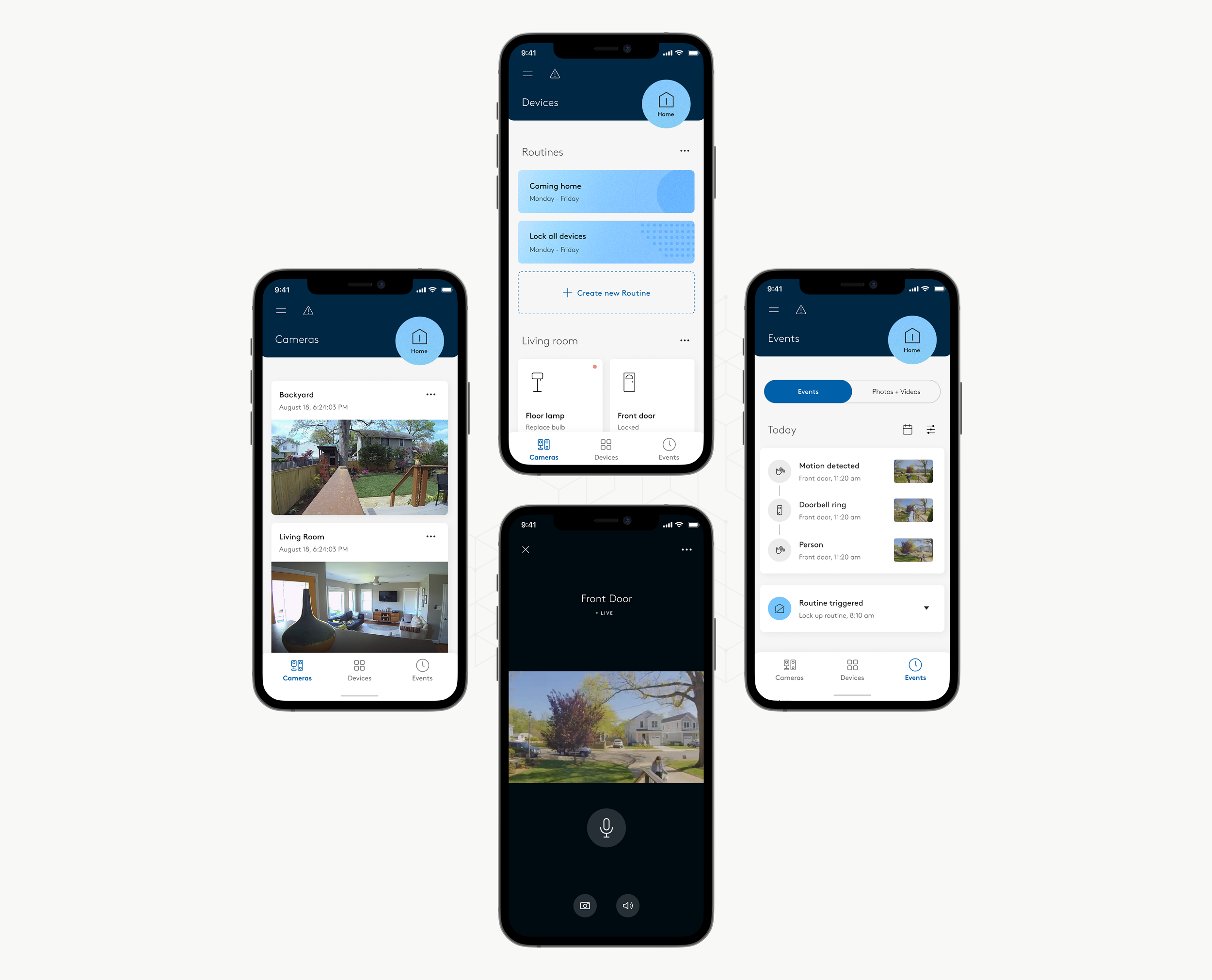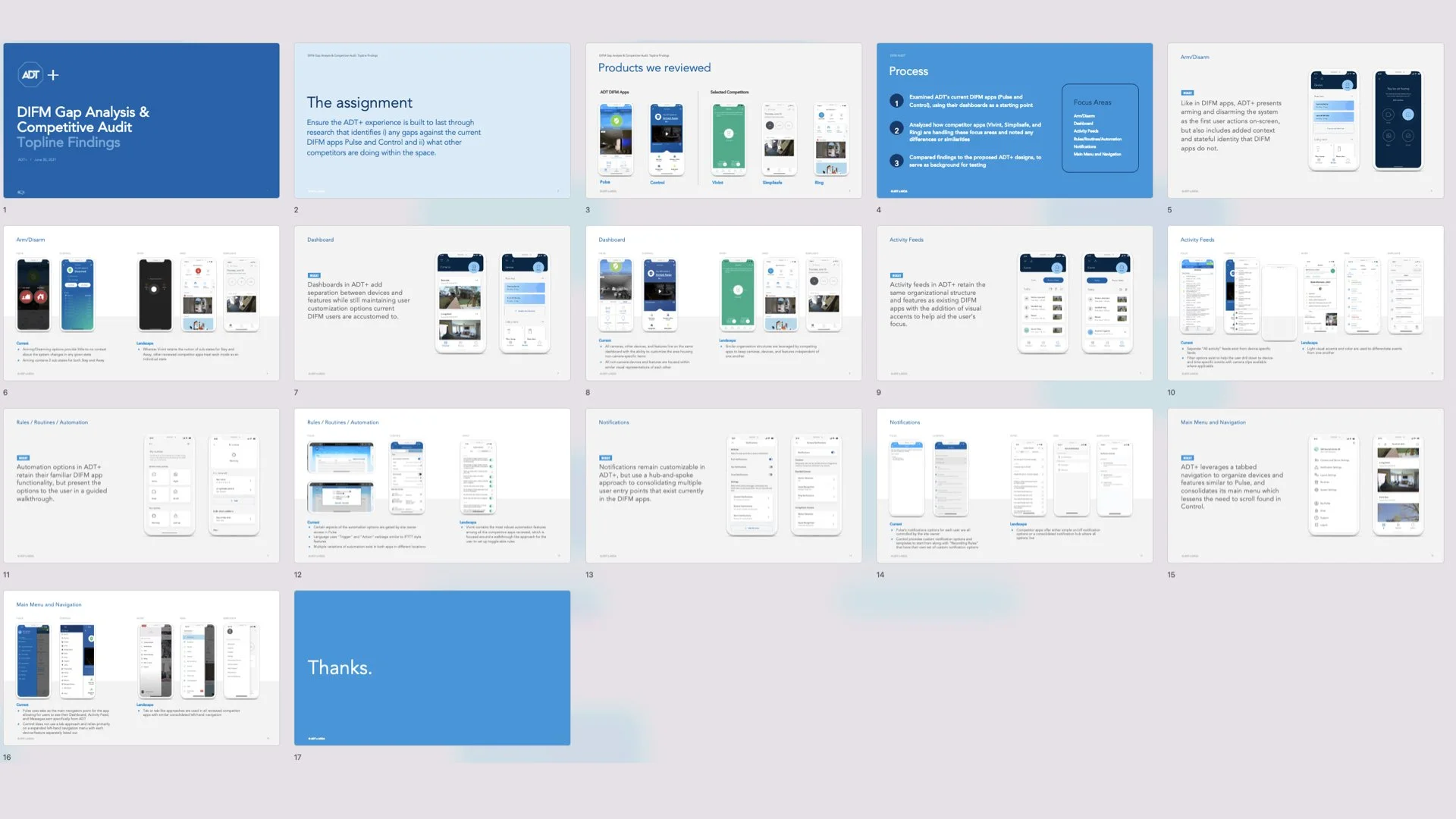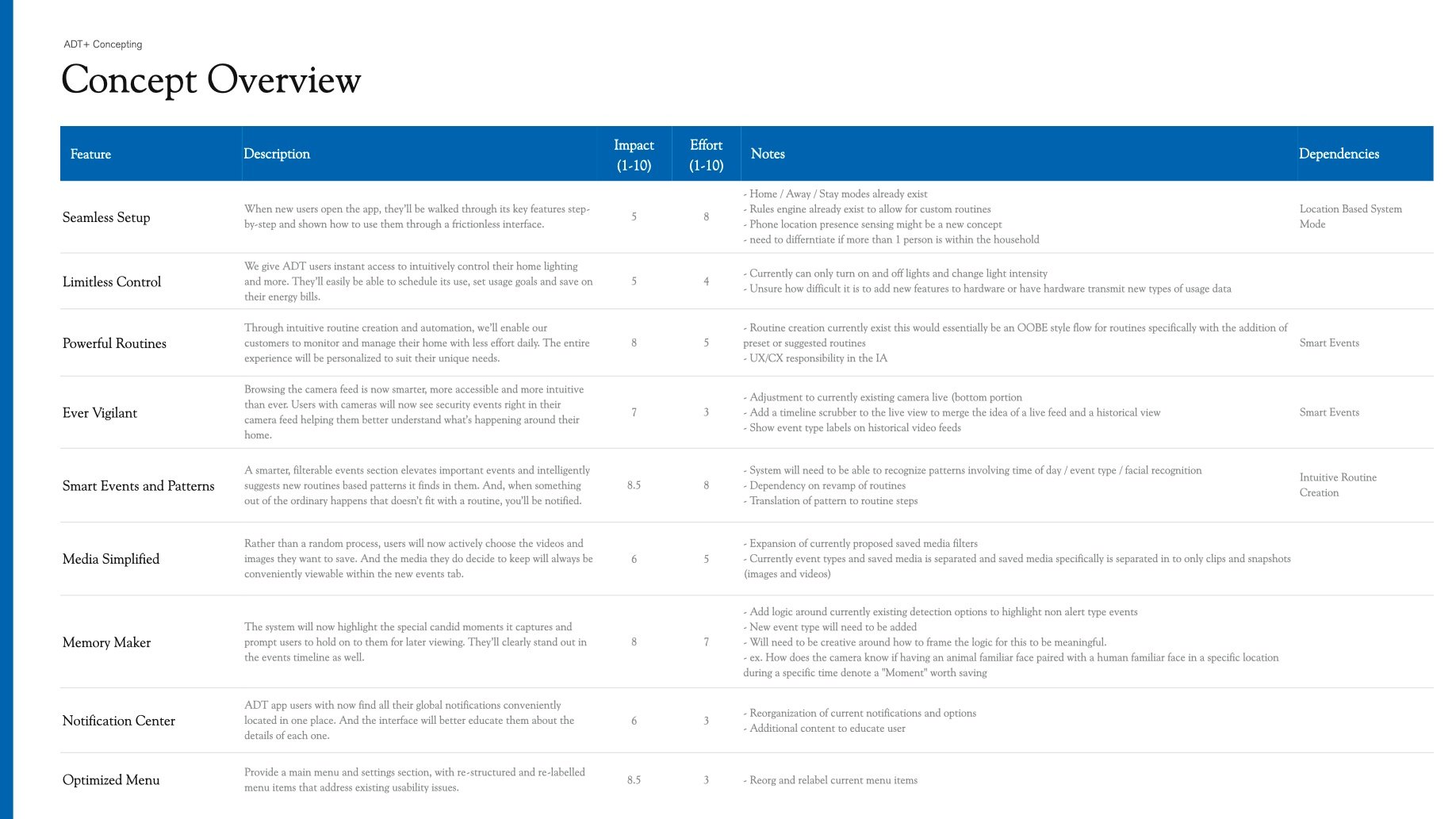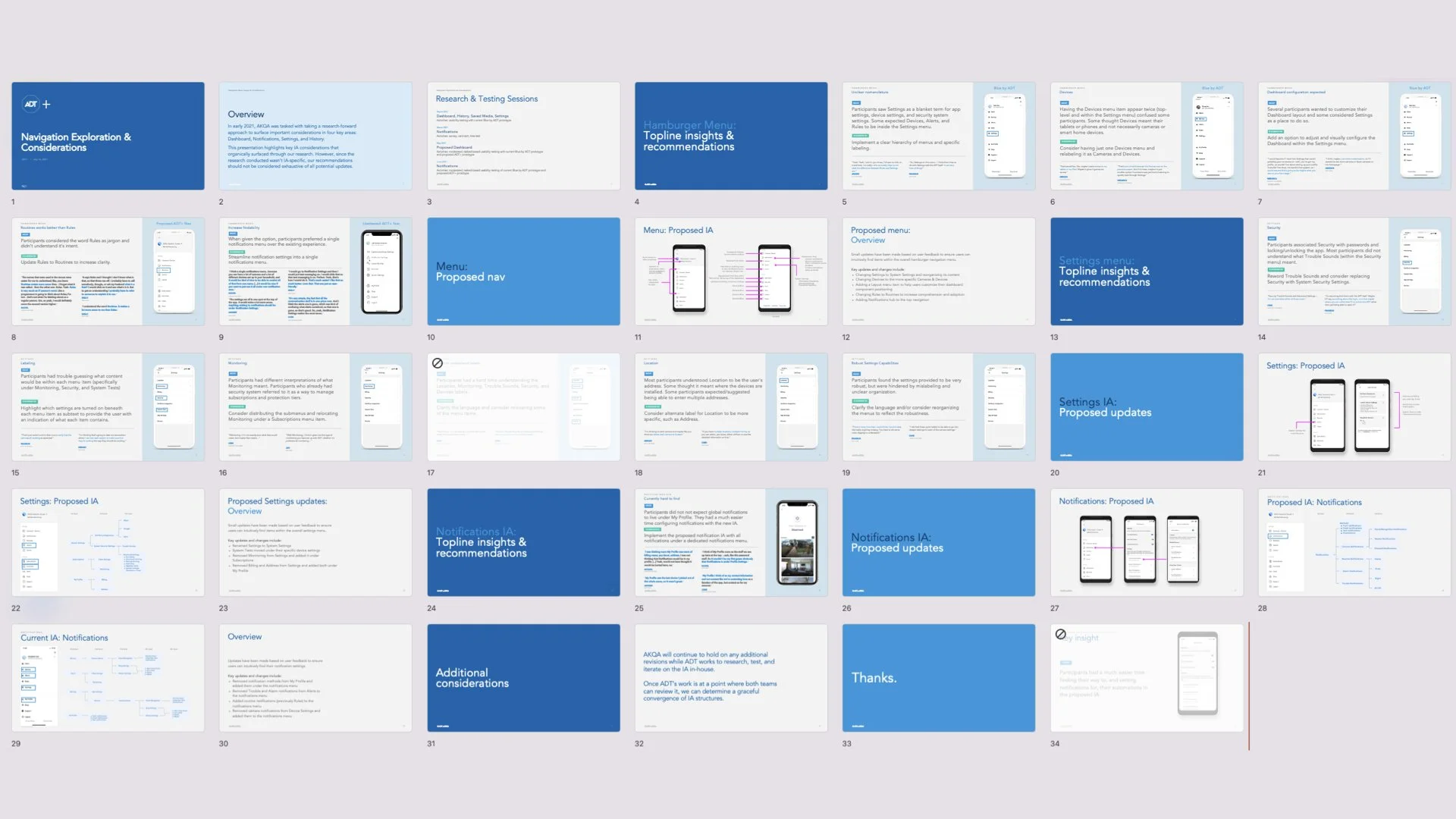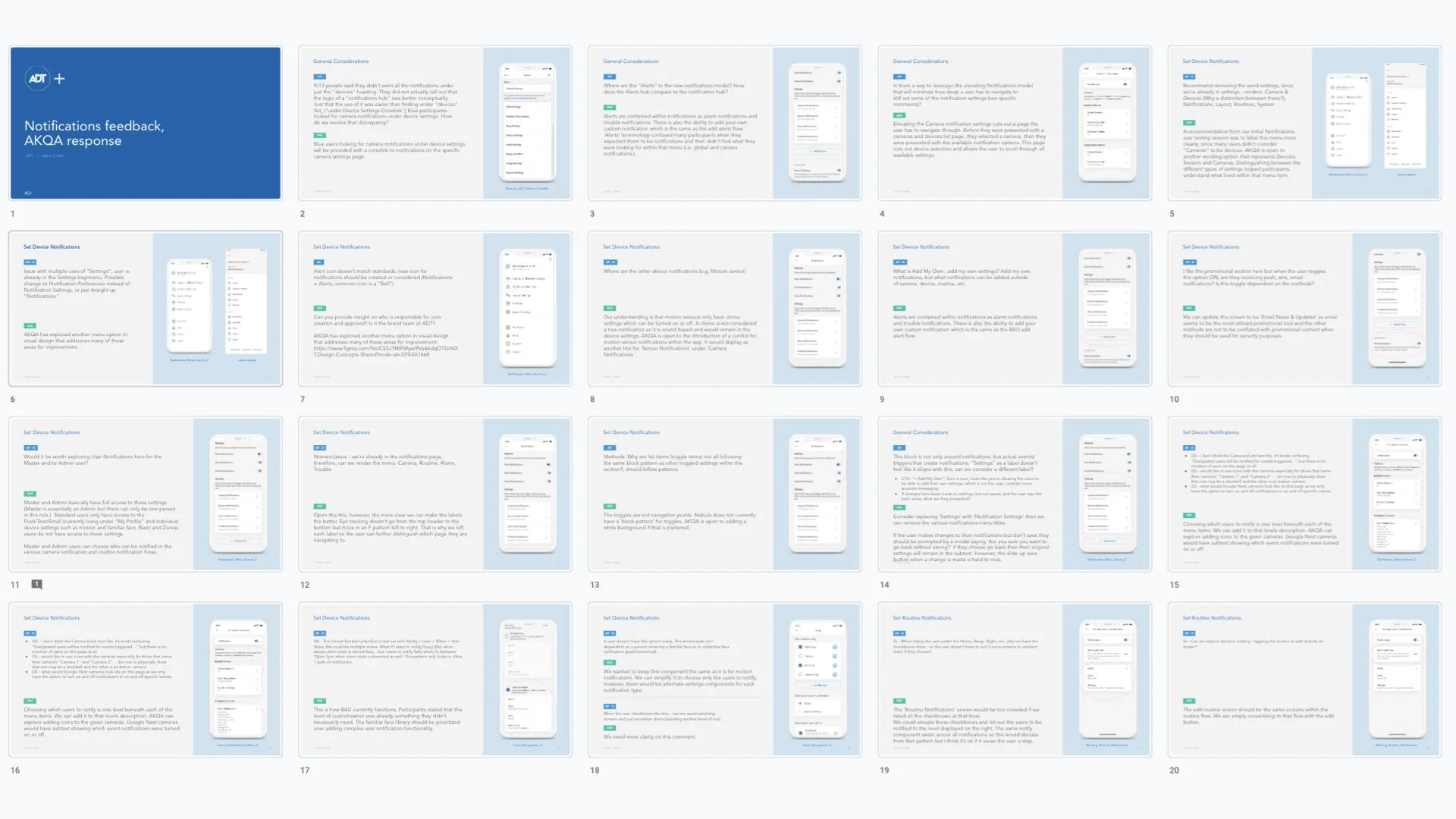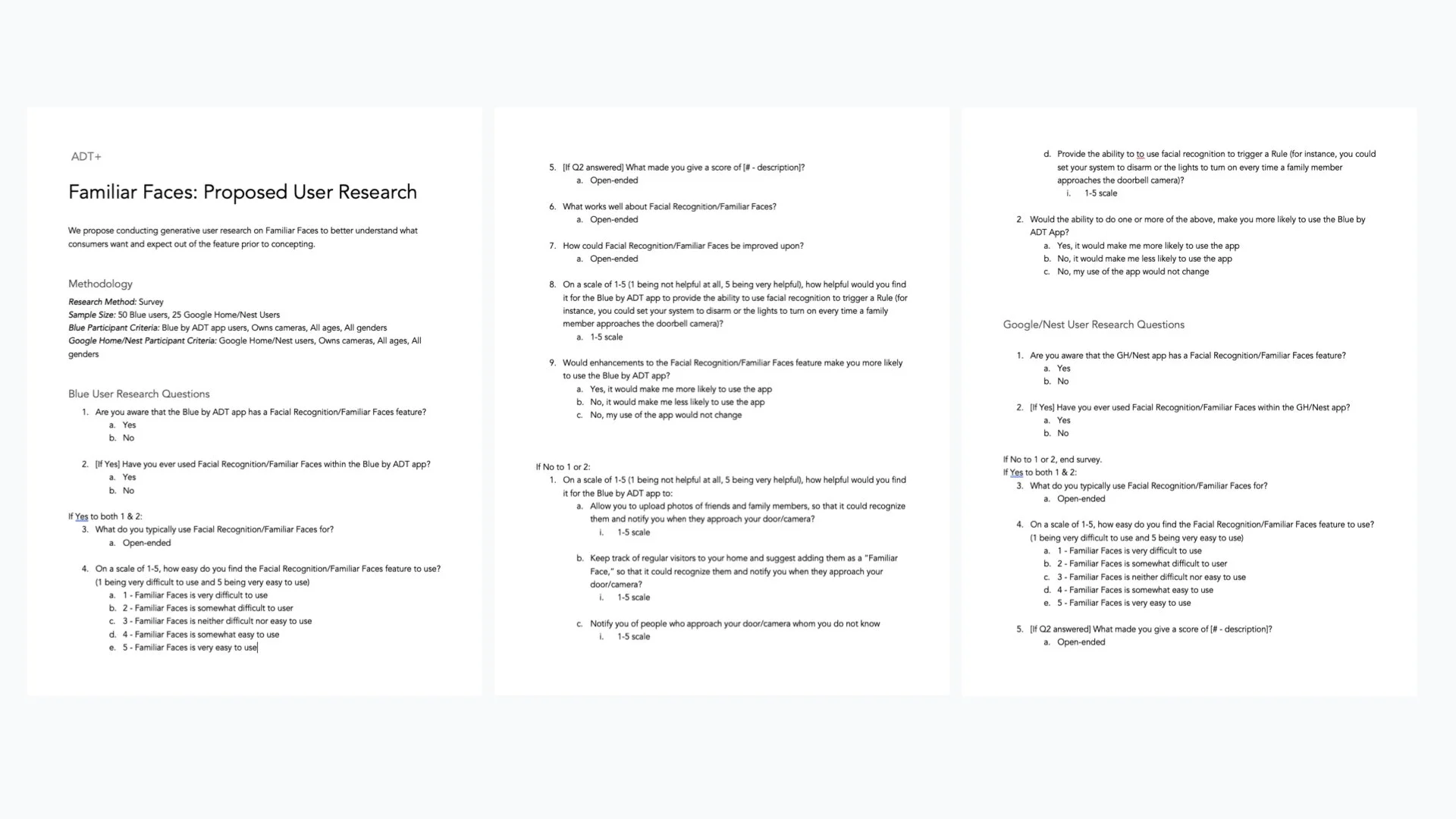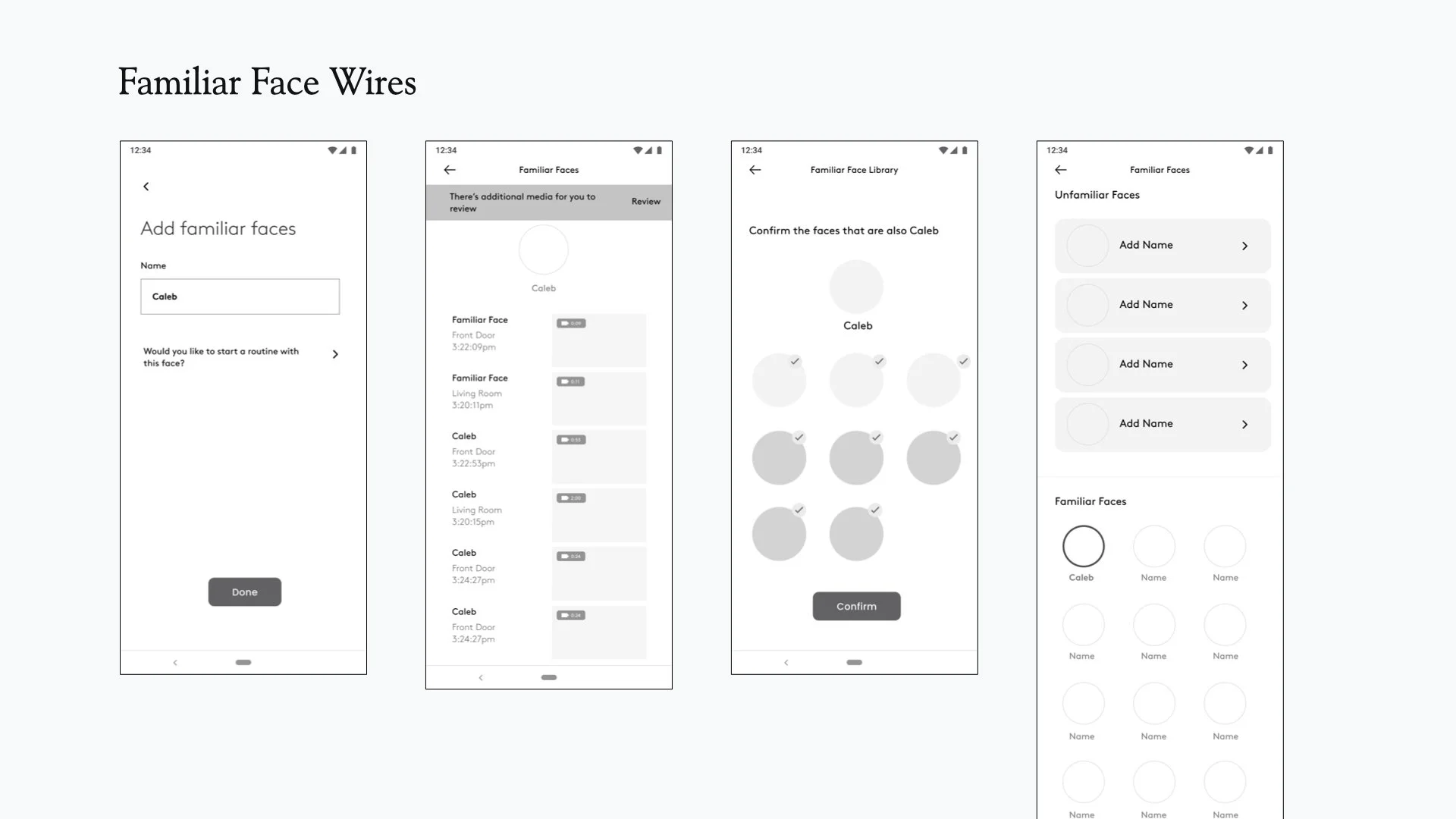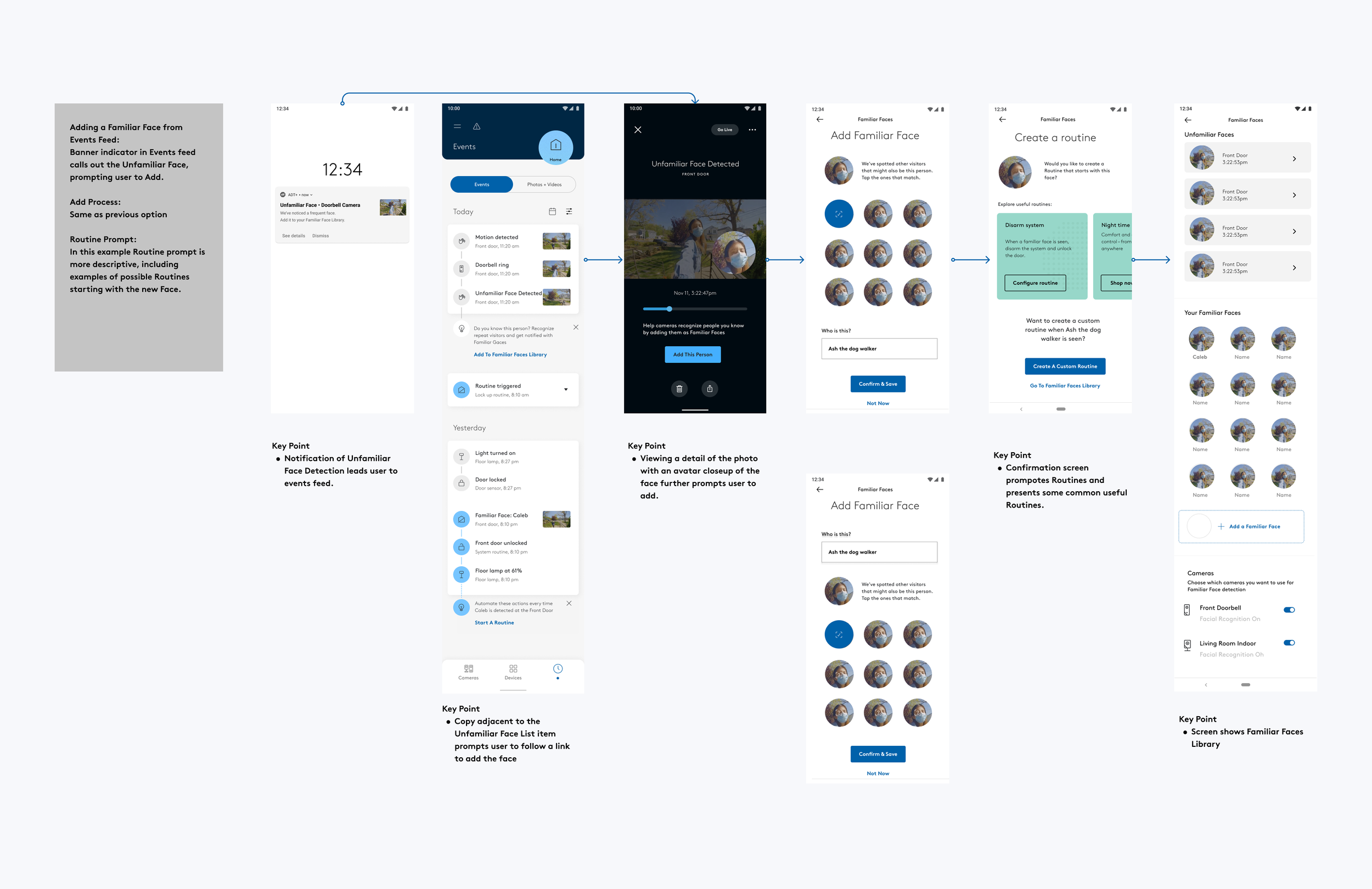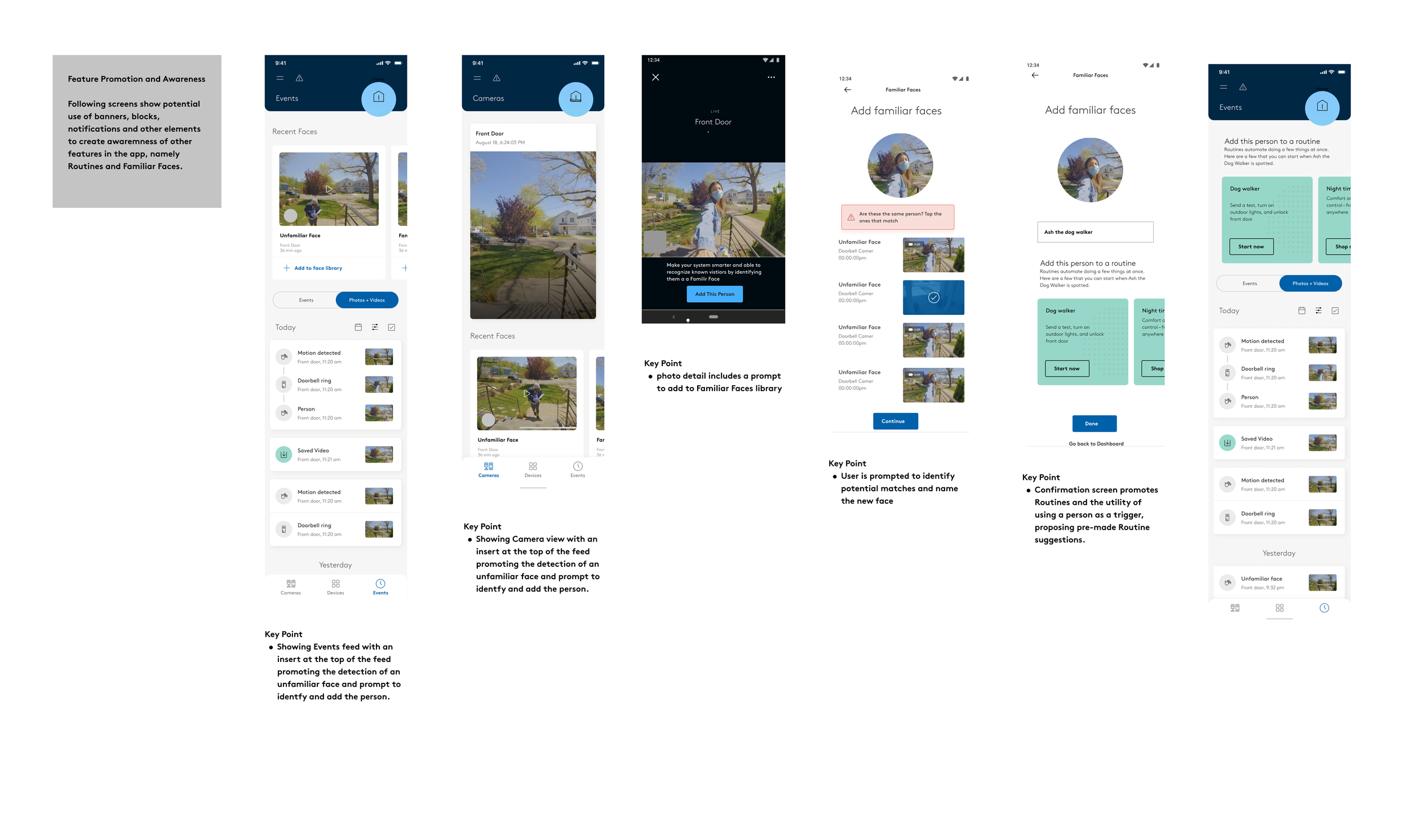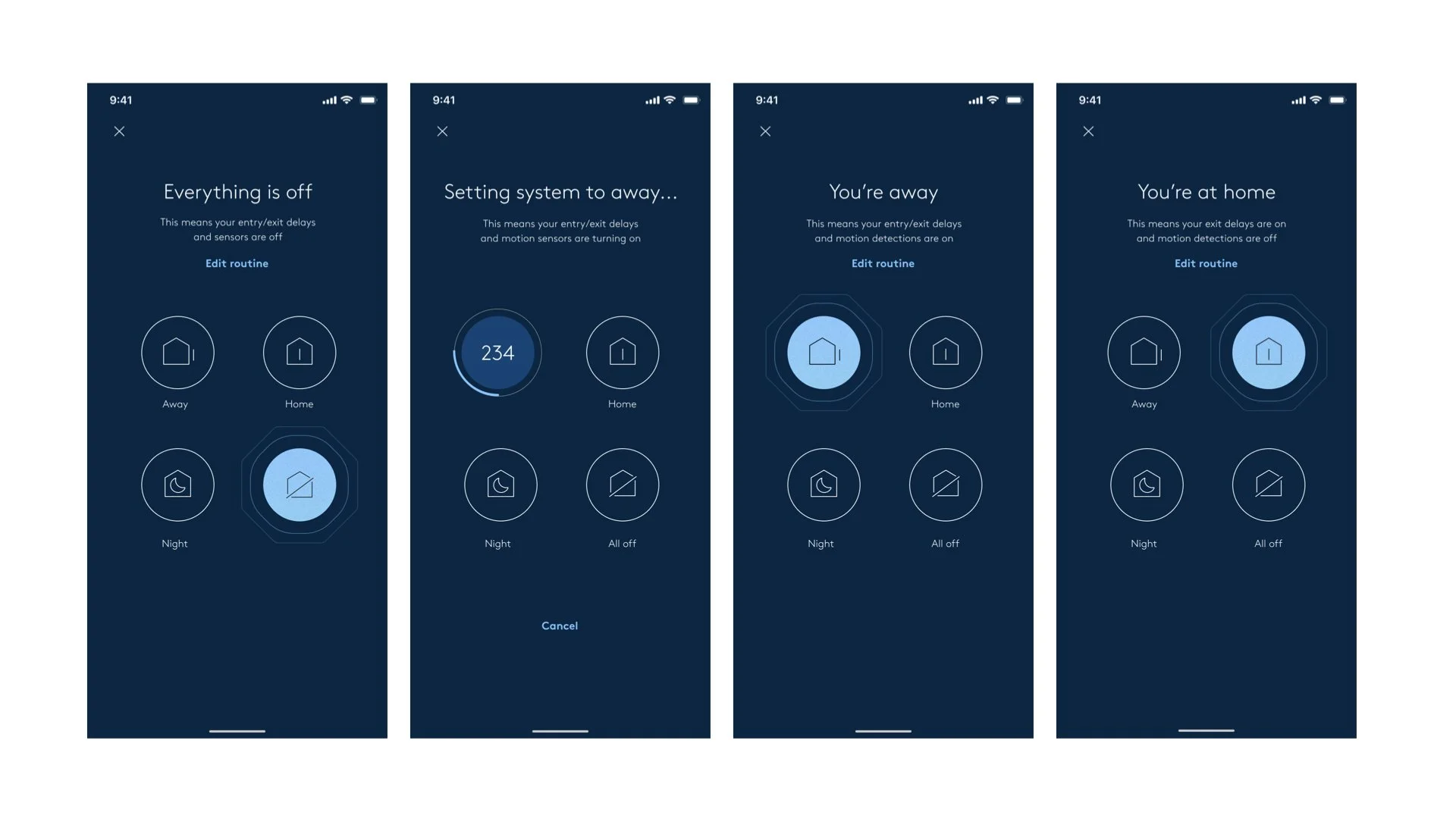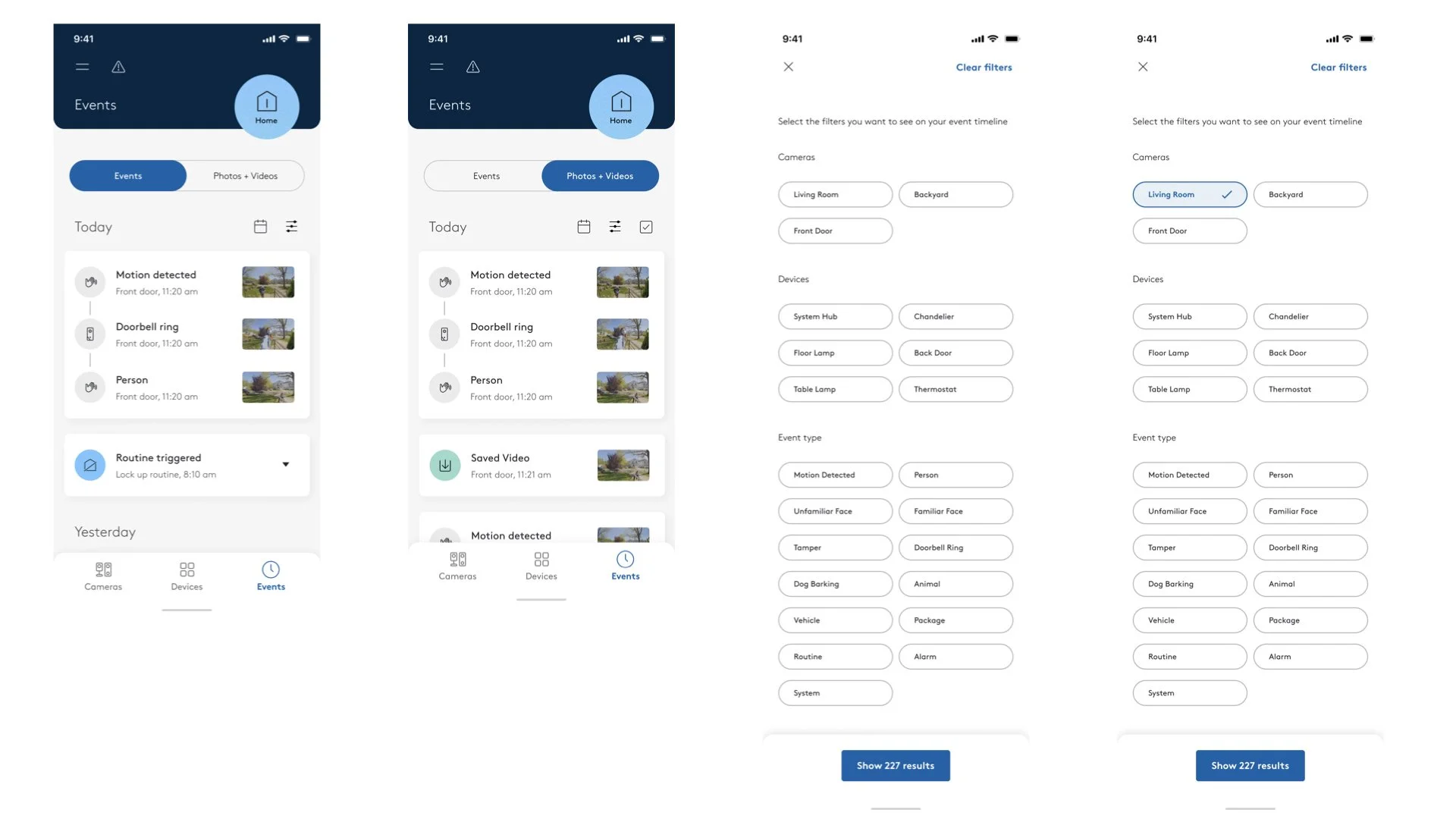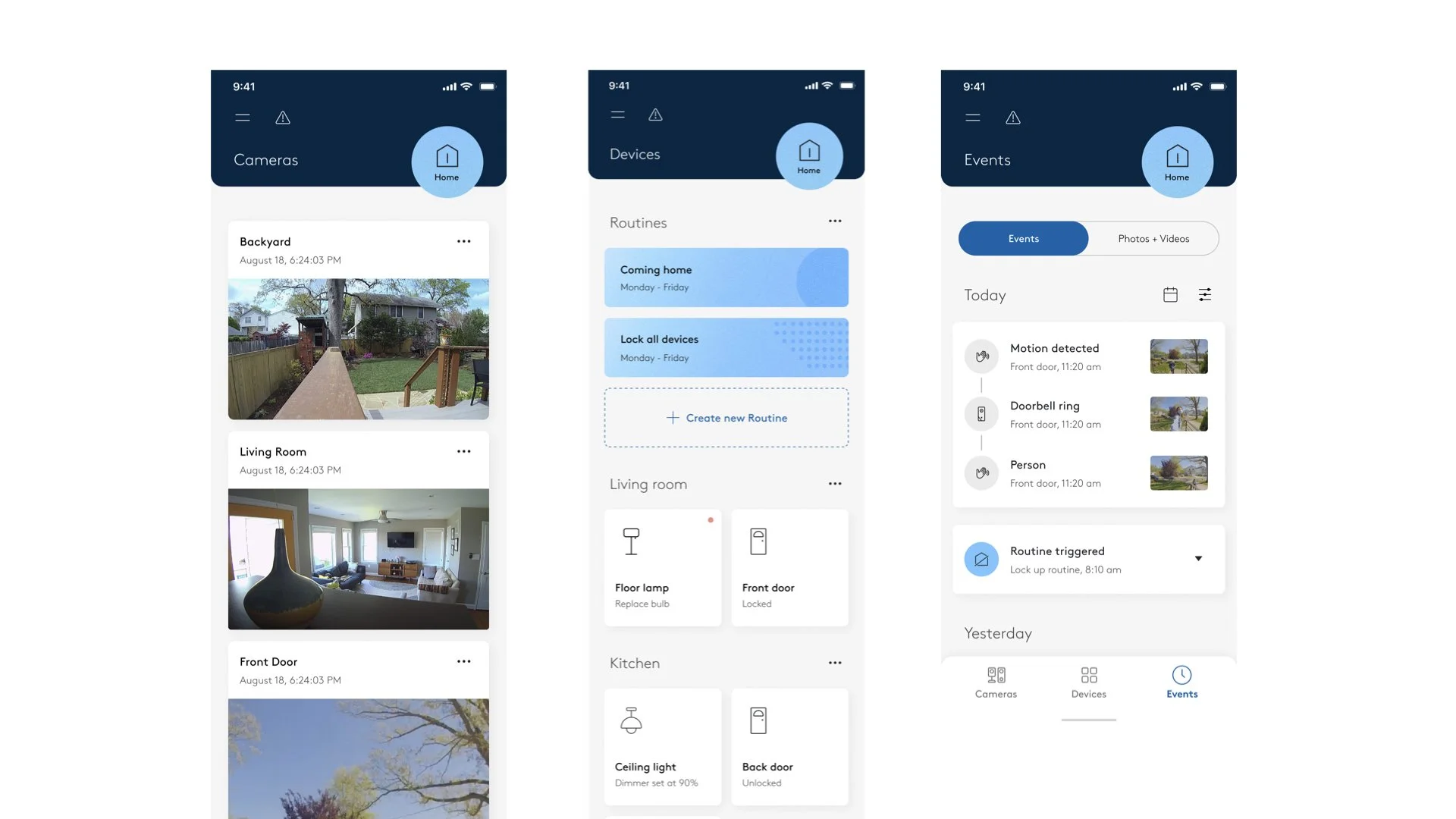ADT+ App
One Powerful, Unified Experience for Home Security
Overview
ADT was operating multiple apps with similar functionality—each tied to different equipment types and presenting core features like system status and video feeds in inconsistent ways. As UX Designer and Researcher, I led the effort to unify these experiences into a single app that delivers a cohesive, trusted user experience across all devices.
This included a key strategic goal: ensuring feature parity with Google Nest cameras and Google Home, to support new integrations and meet user expectations in a competitive smart home ecosystem.
Challenge
ADT users expected a seamless experience regardless of which hardware they installed. But differences in the legacy apps—across UI language, interaction patterns, and feature availability—led to confusion and inconsistent workflows.
We needed to:
Consolidate these apps into a single platform with a unified structure and visual system
Design adaptable flows that work across ADT and Google hardware
Ensure parity in high-value use cases like camera playback, device control, and home mode management
Approach
Best-in-Class Audit
I conducted a thorough audit of top competitors, including Google Nest, Ring, Vivint, and Arlo, identifying how they handle camera access, notifications, and system states. I paid close attention to:
Camera event playback and live view UX
Notification metadata and preview imagery
The Dashboard and consistency of action paths across device types
This audit helped us define the baseline for feature parity and informed the interaction and visual models we used in our redesign.
Audit focus on event playback:




Audit focus on notifications:




Audit focus on Dashboard:




Design Consolidation & Systems Thinking
I documented key patterns across ADT’s existing apps—how the same features behaved differently depending on hardware—and proposed a modular UX framework. This enabled consistency while allowing for contextual flexibility across devices.
Simultaneously, I collaborated with engineering teams to align on how Google integrations would be surfaced and how we’d design interactions that felt natively ADT but respected Google ecosystem constraints.
Strategic Feature Framework
To guide alignment across product, engineering, and design teams, I created a strategic concept matrix mapping potential feature opportunities by impact, effort, and system dependencies.
This framework allowed us to:
Prioritize high-impact, high-feasibility concepts (like Smart Events & Patterns and Optimized Menu)
Identify quick wins vs. longer-term investments
Expose platform and hardware dependencies early in the design process
Facilitate cross-functional conversations rooted in user value and technical reality
By clearly articulating each concept’s value, complexity, and constraints, this document became a living reference that helped inform roadmap decisions and ensure shared clarity across stakeholders.
Research & Testing Timeline
To validate our design decisions and uncover usability issues early, I led a series of structured research and testing sessions across key moments in the product development cycle. These activities allowed us to benchmark the legacy ADT experience, test prototypes for the unified app, and refine the design based on real user feedback.
Key Sessions Included:
March 2021: Usability testing of the current Blue by ADT app focused on the dashboard, history, saved media, and settings
March 2021: Survey, card sort, and tree test to evaluate mental models for notification structure
May 2021: Moderated task-based testing of both the current and proposed dashboard to compare usability and clarity
June 2021: Follow-up task-based testing focused on proposed notification flows
These sessions directly informed decisions around information architecture, interaction models, and system hierarchy—ensuring that we were not just designing what looked good, but what actually worked for real users.
Here are some of the findings and insights:
Familiar Faces: User Research & Early Wireframes
To explore the viability and desirability of a Facial Recognition feature—called Familiar Faces—I initiated early user research across both Blue by ADT and Google Nest customers. The goal was to understand how users perceive facial recognition in a home security context, what features they value, and what might make the experience more useful and trustworthy.
Research Highlights:
Custom surveys were designed for both ADT and Google/Nest user groups
Questions explored usage frequency, perceived helpfulness, privacy concerns, and potential automation triggers
Insights helped identify key drivers of adoption: ease of setup, rule-based automation, and recognition accuracy
Based on those insights, I created early wireframes to map out the user flow for:
Adding and naming familiar faces
Reviewing and confirming matches
Managing unfamiliar or untagged faces
These concepts laid the foundation for further exploration around privacy-safe, value-forward facial recognition—balancing technical feasibility with customer trust and utility.
Smart Events and Patterns
To help users focus on what matters most, I designed a smarter, filterable events section that surfaces meaningful activity, identifies routine patterns, and proactively notifies users when something out of the ordinary occurs. This concept transforms passive logs into an intelligent feed—giving users clarity, control, and confidence.
This feature addressed key pain points:
Difficulty filtering or prioritizing events
Lack of visibility into routine exceptions or anomalies
Missed opportunities to turn behavior into helpful automations
Value for Customers:
Offers a focused, streamlined way to monitor what’s important
Enables personalized automation based on actual user patterns
Saves time while adding context and control to the home experience
Value for ADT:
Elevates engagement by providing proactive, insight-driven functionality
Strengthens ADT’s positioning as a smart, customer-centric security platform
This feature was rated high impact and moderate effort, making it a strategic priority in our roadmap planning.
From Event Noise to Smart Routines
Designing Automation That Feels Human and Useful
This feature reimagines the traditional activity feed by surfacing meaningful patterns and transforming them into personalized routines—making ADT smarter, calmer, and more predictive.
Through user research and system mapping, I identified key friction points around how users filtered events, spotted anomalies, and created automations. Most struggled to translate observed behavior into actionable, recurring routines—especially across multiple device types.
To address this, I designed a guided routine builder that works in concert with a smarter, pattern-aware event system. As shown here, users can:
Select devices and system states they want to automate (e.g., lights off, doors locked)
Stack actions and layer optional conditions
Receive proactive suggestions based on recurring behavior
Name and assign notifications for routine completion
These flows were crafted to feel lightweight and familiar, yet flexible enough for advanced users. The end goal was to reduce decision fatigue and elevate moments of automation from something purely functional to something reassuring and confidence-building.
System Modes: Clear, Calm, and Actionable
Visuals: Away/Home/Night/All Off states
One of the most critical interactions in the app—arming and disarming the system—was often confusing in earlier versions. I redesigned this core flow to:
Visually reinforce each state (Away, Home, Night, All Off) with iconography, animation, and motion feedback
Clarify what each mode means (e.g., what sensors are active, whether exit delays are on)
Reinforce successful state changes and reduce friction in transitions
This part of the experience was built to be glanceable, tactile, and trusted—particularly during high-stress moments like leaving the house or turning in for the night.
Reimagined Event Timeline + Smart Filtering
Visuals: Event feed, filter UI
The original event feed was overwhelming—filled with repetitive, unprioritized notifications. I redesigned this space to feel smarter and more scannable, with:
A clean visual hierarchy to help users quickly identify meaningful events
Context-rich icons, preview thumbnails, and routine tagging
A robust, user-friendly filter system that allows users to drill down by camera, device, or event type (e.g., “Unfamiliar Face,” “Package,” “Routine”)
This gave users more agency over their data, while laying the groundwork for smart pattern recognition and future automations.
Devices, Routines & Cameras in One Unified Ecosystem
Visuals: Cameras tab, Devices tab with Routines module, Events tab
To consolidate multiple ADT apps into one cohesive platform, I designed a shared architecture and interaction model that works across device types—door locks, lighting, thermostats, cameras, and sensors. This included:
A modular Devices dashboard that adapts to room context and device status
Routines surfaced inline and editable from multiple entry points
Smart device control entry point organized by room
An events feed with smart events and routines
Everything was built to scale—whether the user has two smart lights or an entire smart home.
Solution
I led the end-to-end design of a unified experience that simplifies complexity and instills user confidence across every interaction. The final solution delivers a seamless, scalable, and emotionally intelligent platform built for both current and future ADT customers.
Key features include:
Simplified System Modes: A clear, guided interface for arming and disarming, with visual feedback and contextual messaging for each mode (Home, Away, Night, All Off)
Unified Dashboard: A central hub showing real-time system status and high-priority actions at a glance
Integrated Camera Experience: Live view, timeline scrubbing, and event filtering across both ADT and Google Nest devices
Reimagined Alerts: Intuitive, urgency-aware flows that help users act quickly during critical moments
Adaptive Onboarding: Context-aware setup flows that adjust based on devices detected and household layout
Smart Device Controls: Modular control panels for locks, lights, sensors, and thermostats—organized by room and device type
Outcome
These solutions were rigorously tested with both current ADT users and smart home early adopters. Testing showed marked improvements in:
Task Completion Rates: Faster setup and resolution across core flows
Clarity & Confidence: Users reported feeling more in control, particularly when handling system modes and reviewing security events
Perceived Ease of Use: Flows were described as “calm,” “clean,” and “reassuring”—a direct reflection of our emotional design strategy
Stakeholders noted that the experience felt “smarter, calmer, and more cohesive than anything we’ve done before,” and the system design laid a strong foundation for long-term product growth and innovation.
